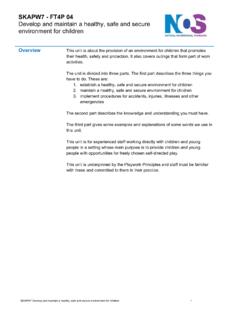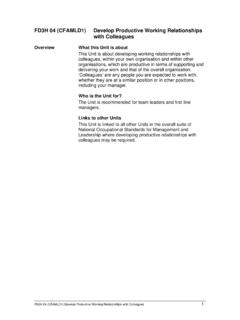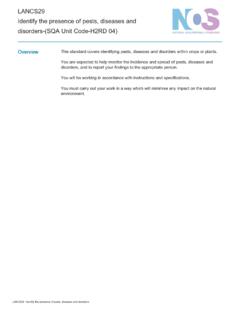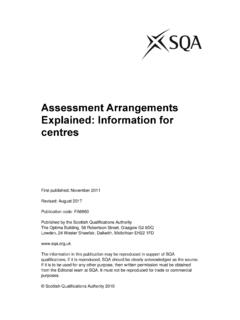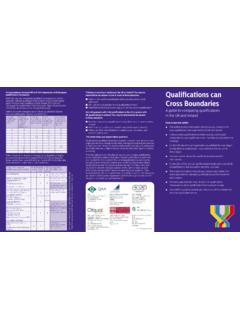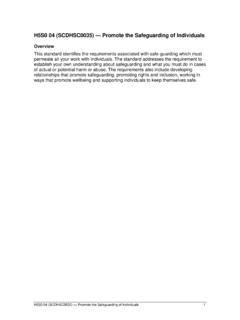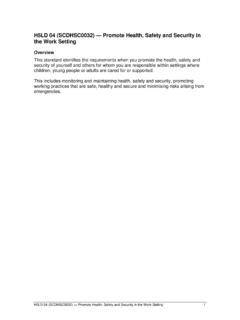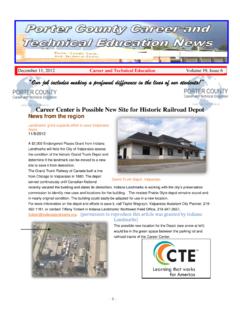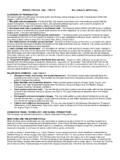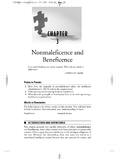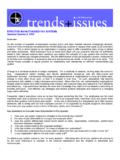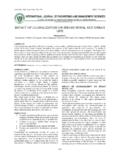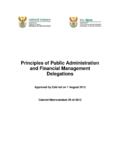Transcription of H7LX 04 (SCDLMCB7) Lead and Manage Group Living …
1 H7LX 04 (SCDLMCB7) Lead and Manage Group Living Provision with care services 1 H7LX 04 (SCDLMCB7) Lead and Manage Group Living Provision with care services Overview This standard identifies the requirements associated with leading and managing Group Living provision, it includes developing the physical environment, daily Living activities and Group activities in such a way as they support the achievement of positive outcomes for individuals. H7LX 04 (SCDLMCB7) Lead and Manage Group Living Provision with care services 2 Additional Information Scope/range related to Performance Criteria The details in this field are explanatory statements of scope and/or examples of possible contexts in which the NOS may apply; they are not to be regarded as range statements required for achievement of the NOS. Active participation is a way of working that regards individuals as active partners in their own care or support rather than passive recipients. Active participation recognises each individual s right to participate in the activities and relationships of everyday life as independently as possible.
2 A person s background is the individual s unique mix of personal experiences, history, culture, beliefs, preferences, family relationships, informal networks and community. Critically evaluate is to weigh arguments for and against something, assessing all evidence, this could relate to factors such as models of care service delivery, policy development, theories, approaches to practice. Critical evaluation requires a weighing up and making judgements on factors such as currency, relevance, validity, outcomes, cost, sustainability, risk, and fitness-for-purpose of a product or a service against other products, services or ideas, using relevant criteria to frame the evaluation and inform decision-making. Development opportunities may include a blend of educational programmes, training activities, mentoring, coaching, shadowing, supervision, guided reading, research, action learning sets, peer Group discussions. The individual is the person you support or care for in your work.
3 Key people are those who are important to an individual and who can make a difference to his or her wellbeing. Key people may include family, friends, carers and others with whom the individual has a supportive relationship. Others are the workers that you Manage , your colleagues and other professionals whose work contributes to the individual s wellbeing and who enable you to carry out your role. H7LX 04 (SCDLMCB7) Lead and Manage Group Living Provision with care services 3 Scope/range related to Knowledge and Understanding The details in this field are explanatory statements of scope and/or examples of possible contexts in which the NOS may apply; they are not to be regarded as range statement required for achievement of the NOS. All knowledge statements must be applied in the context of this standard. In relation to all knowledge statements you need to know and understand the specified areas of knowledge and be able to critically apply the knowledge and understanding in your leadership and management practice.
4 Active participation is a way of working that regards individuals as active partners in their own care or support rather than passive recipients. Active participation recognises each individual s right to participate in the activities and relationships of everyday life as independently as possible. Critically analyse is to examine something closely such as a policy, procedure, theory, complex situation, problem or an approach to practice identifying the parts or issues that contribute to the whole product, situation or idea and determining how these different parts affect the quality of the whole product or how the individual issues affect the overall situation. Critical analysis involves a weighing-up of the factors concerned, for their contribution of strengths/weaknesses or advantages/disadvantages of a product or in a situation. Critical analysis is part of the process of understanding issues and developing original and creative responses. Critically evaluate is to weigh arguments for and against something, assessing all evidence, this could relate to factors such as models of care service delivery, policy development, theories, approaches to practice.
5 Critical evaluation requires a weighing up and making judgements on factors such as currency, relevance, validity, outcomes, cost, sustainability, risk, and fitness-for-purpose of a product or a service against other products, services or ideas, using relevant criteria to frame the evaluation and inform decision-making. Employment practices should include recruitment, performance management, disciplinary procedures, grievance procedures. Evidence based practice uses systems, processes and practice wisdom that has been proved to be effective in supporting the achievement of positive outcomes. Evidence may have been drawn from a variety of sources: research, both formal and informal, and the views and opinions of individuals, key people and those involved in the delivery of care services . H7LX 04 (SCDLMCB7) Lead and Manage Group Living Provision with care services 4 Factors that may affect the health, wellbeing and development may include adverse circumstances or trauma before or during birth; autistic spectrum disorder; dementia; family circumstances; frailty; harm or abuse; injury; learning disability; medical conditions (chronic or acute); mental health; physical disability; physical ill health; poverty; profound or complex needs; sensory needs; social deprivation; substance misuse.
6 Leadership is the ability to provide strategic direction and a sense of purpose. Effective leaders create a sense of trust, confidence and belief, inspiring people to adopt the values and behaviours they promote. They are innovative, creative and motivating. Management is the ability to set the operational direction and organise the effective running of the service provision to meet the overall service needs including ethical, legislative, regulatory and organisational requirements. Effective managers facilitate and organise resources in order to optimise the performance of others, allowing them to carry out tasks and achieve goals efficiently and effectively. They provide clarity and accountability that enable teams to meet their objectives. Outcomes are the changes or differences that individuals or care services are trying to achieve. Hard outcomes are changes that are clear and obvious, or those that involve a visible change in people's behaviour or circumstances. Soft outcomes are changes that are less easy to observe and measure, or those that involve more subtle changes inside people such as a change in someone s attitude, sense of wellbeing or how they see or feel about themselves.
7 Outputs are the tangible products, services or facilities that are a result of organisational activities or the activities of those involved in the delivery of the service provision. Outputs may be used to achieve outcomes. Personalisation can be defined as 'changing the power balance so that each person really does have choice and control over the care services that they want. From being a recipient of services , individuals become involved in selecting and shaping the services they use'. Personalisation is a social care approach that encompasses citizen-directed support; self-directed support; the use of direct payments or personal budgets; the provision of accessible information and advice on care and support and the promotion of independence and self-reliance amongst individuals and communities. Depending on how it is used the power and influence of leaders and managers may have either a positive or negative effect upon relationships. H7LX 04 (SCDLMCB7) Lead and Manage Group Living Provision with care services 5 Values Adherence to codes of practice or conduct where applicable to your role and the principles and values that underpin your work setting, including the rights of children, young people and adults.
8 These include the rights: to be treated as an individual to be treated equally and not be discriminated against to be respected to have privacy to be treated in a dignified way to be protected from danger and harm to be supported and cared for in a way that meets their needs, takes account of their choices and also protects them to communicate using their preferred methods of communication and language to access information about themselves H7LX 04 (SCDLMCB7) Lead and Manage Group Living Provision with care services 6 Performance Criteria What you do in your job You must provide evidence to meet all the 36 Performance Criteria for this Unit. The Performance Criteria are grouped under headings to assist you with planning how best to meet these points. Place the number of the piece of work where this Performance Criteria has been met in the evidence box after each criteria. Lead on the development of the physical environment to support the achievement of positive outcomes for individuals Performance Criteria Evidence Number where this criteria has been met 1 Lead practice that recognises and respects individuals background and preferences.
9 2 Optimise the use of the physical environment to meet the purpose of the service provision and support the achievement of positive outcomes for individuals. 3 Lead the development of an environment that reflects the backgrounds, preferences and needs of individuals. 4 Lead the development of an environment that supports the wellbeing of individuals. 5 Ensure that the environment makes provision for the privacy of individuals. 6 Ensure that the physical environment is decorated, furnished and maintained to a high standard. 7 Ensure that individuals are able to personalise their private space and keep their possessions safe and secure. 8 Manage an environment that facilitates the free movement of individuals whilst taking account of any restrictions that are placed upon them. 9 Manage a safe environment that protects individuals from harm. H7LX 04 (SCDLMCB7) Lead and Manage Group Living Provision with care services 7 Lead on the development of the physical environment to support the achievement of positive outcomes for individuals (cont) Performance Criteria Evidence Number where this criteria has been met 10 Ensure that the environment supports the active participation of individuals.
10 11 Ensure that the physical environment meets legislative, regulatory and organisational requirements. Lead and Manage the planning, implementation and evaluation of daily Living activities 12 Ensure that the planning and implementation of daily Living activities reflects the backgrounds, preferences, needs and wishes of individuals. 13 Ensure that individuals are supported to actively engage in daily Living activities. 14 Ensure that individuals are supported to Manage the balance between free, leisure and structured time. 15 Develop systems and processes that ensure that individuals are central to decisions about daily Living activities. 16 Secure resources for a range of daily Living activities. 17 Develop systems and processes that monitor and evaluate daily Living activities. 18 Ensure that daily Living activities are evaluated regularly with individuals and others. 19 Ensure that daily Living activities are adapted in order to respond to changing preferences and needs.

